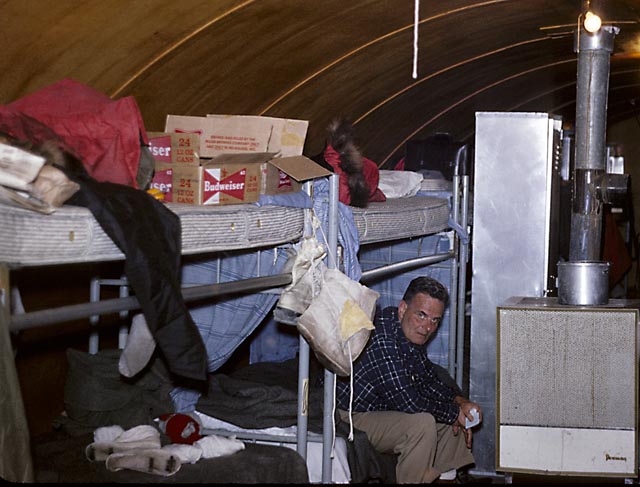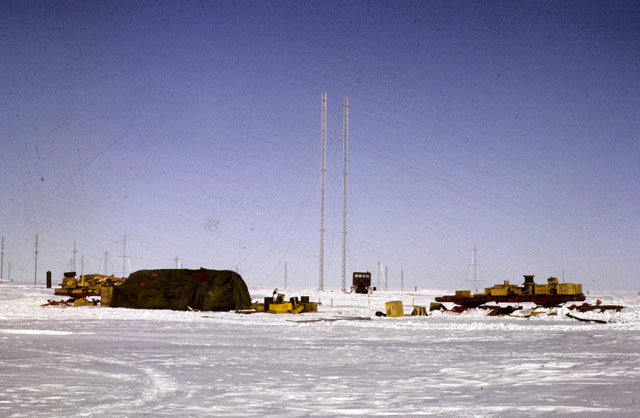
Photo Credit: Wesley B. Harding
|
A man installs an antenna on a tower near McMurdo Station for an experiment during the 1963-64
field season called Antarctic Forward Scatter Radio Propagation Network.
|
A holiday to remember
A son connects to his father through the decades from Antarctic field camp
By Ben Harding, Special to the Sun
Posted January 16, 2015
My father, Wesley B. Harding, came to Antarctica a little more than 50 years ago to install an early experiment to study cosmic rays from the sun.
On Christmas Day 2014, sitting at a computer in the McMurdo Dry Valleys working on altogether different research project, I called my sister on a satellite phone. We reminisced about talking to Dad over a shortwave radio, and once over a phone patch to a shortwave radio connection, during that 1963-64 field season.
Over a two-month period, he supervised the construction of antennas and installed electronic and radio equipment he had designed and built, all to be used as part of the Antarctic Forward Scatter Radio Propagation Network.

Photo Credit: Wesley B. Harding
Wesley B. Harding, presumably at McMurdo Station.

Photo Credit: Wesley B. Harding
Two naval icebreakers in McMurdo Sound near McMurdo Station in 1963-64.

Photo Credit: Wesley B. Harding
One of the field sites for the Antarctic Forward Scatter Radio Propagation Network.
Dad was rated as an electronic engineer at the Central Radio Propagation Lab (CRPL) of the National Bureau of Standards at its laboratory in Boulder, Colo., where we lived. He had never graduated high school, dropping out to join the Marines, sometime around 1930 when his father, my grandfather and namesake, died.
Dad got his GED when he volunteered for service during World War II. He was trained to be a radio operator on B-25 light bombers, first doing anti-submarine patrols off the U.S. East Coast, and later flying missions with Claire Chennault’s 14th Air Force, the Flying Tigers, in Kunming, China.
In the Army Air Corps, Dad turned a hobby of building radios, something he had pursued from childhood, into a profession. Following the war, he worked first at the Naval Gun Factory in Washington D.C., and then transferred to the Bureau of Standards in Boulder. At the Bureau, he earned the profound respect of his colleagues, who all had college educations, and many with advanced degrees, for his knowledge, creativity, technical skills and work ethic.
The Antarctic Forward Scatter Radio Propagation Network consisted of four transmission paths in an odd, zigzag pattern across the Antarctic continent. One path led from McMurdo Station to the Russian base at Vostok. The American Byrd Station was the origin for two paths, one to McMurdo and one to the South Pole Station. From the South Pole Station, a path led to the British Station at Halley Bay.
Forward scatter of radio waves occurs when the signal passes through a large number of small irregularities in the ionization of the atmosphere, much like how light is scattered by many small water droplets in a fog. One can make inferences and estimates about the number and energies of cosmic rays from the nature of the forward scatter.
The antennas of the network were designed to “focus” on an area of the atmosphere about 85 kilometers above the earth at the midpoint of the path. This altitude was favorable for sensing the flux of cosmic rays originating from the sun.
The experiment was installed in anticipation of the 1964-65 International Year of the Quiet Sun (International Quiet Sun Year, IQSY), which followed on the success of the 1957-58 International Geophysical Year (IGY). The IGY was an unprecedented international effort to study the Earth in all its aspects, including the polar regions. It led to the eventual establishment of the U.S. Antarctic Program, which is managed by the National Science Foundation today.
IGY was timed to coincide with a “solar maxima,” a year of maximum solar activity. It was a great success; the sun cooperated, with the highest number of sunspots ever recorded over the two centuries since the procedure for counting sunspots had been standardized.

Photo Credit: Wesley B. Harding
The towers erected for the project were among the tallest structures ever installed in Antarctica.
Even as IGY was underway, some scientists came to the realization that certain observations would be valuable during a solar minima. This led to IQSY and the development of the Antarctic Forward Scatter Radio Propagation Network.
Scientists at the CRPL, along with scientists from the Bartol Research Foundation at the University of Delaware, conducted the forward-scatter cosmic ray research. Among the scientists was D. K. Bailey, who first discovered the atmospheric forward-scatter phenomenon. (Incidentally, Martin A. Pomerantz was the U.S. chair of the IQSY committee. The Martin A. Pomerantz Observatory, or MAPO, at Amundsen-Scott South Pole Station is named in his honor.)
The forward scatter network was located in Antarctica because the nature of the Earth’s magnetic field at the poles presents much less impediment to the entry of cosmic rays than at lower latitudes. This made the experiment more effective, but made logistics much, much more difficult.
Dad and his co-worker, Milton “Woody” Woodward, left the U.S. on Dec. 16, 1963 and would spend the next two months traveling hundreds of miles around the continent to set up the network before leaving on Feb. 21.
It is remarkable what they were able to accomplish in about ten days at each station. At McMurdo, South Pole and Byrd, they had to install two antennas each, on two steel towers, along with two electronic systems. The British handled antenna construction and equipment installation and calibration at Halley Bay.

Photo Credit: Wesley B. Harding
A Russian vehicle in Antarctica from 1963-64.
At South Pole Station, the transmitting antenna for the Halley Bay path was 177 feet tall, at the time (and perhaps still today) the tallest structure ever constructed in Antarctica. The antenna design called for a height of 217 feet, but this was reduced because of concerns about safety.
What else was remarkable about this program was the cooperation with the Russians at Vostok. Keep in mind that this was less than three years since the failed Bay of Pigs invasion of Cuba, and only about a year after the Cuban Missile Crisis.
Dad came back and told me “We don’t have a [problem] with those people, they are the nicest people on Earth.” This has remained to me testimony to the power of people-to-people contact. (I was fortunate enough to visit the Soviet Union in August 1989 and had the same experience.) Dad admired the Soviet Union’s over-the-snow equipment, but their pilots did not have adequate sunglasses, so he gave his Navy-issue Ray Ban Aviator sunglasses to one of the Soviet pilots.
Strange to think that today I can send emails from a field camp and that balloons with sophisticated solid-state cosmic ray sensors are being launched from near McMurdo and flying circumpolar orbits at altitudes of more than 100,000 feet.
Dad died in 1993. He would have loved seeing how far technology has progressed.
Ben Harding is a water resources engineer from Boulder, Colorado. He is the lead this year for the McMurdo Dry Valleys Long Term Ecological Research program’s “Stream Team.” This is his second time to the Ice. Previously, he deployed during the 2003-04 season with the Stream Team. His work in the United States involves a broad range of water-related planning and analysis, from basin-scale climate-change impact modeling studies, to simulating the fate and transport of contaminants in municipal water distribution networks.










